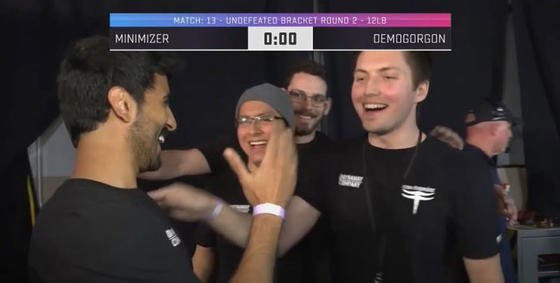
From left to right: Rashed Almazrouei, Brian Romero, Nicholas Lechner, and
Sean Becker (team lead).
Battlebots is a nationally televised competition where robots battle in a closed arena. It is a breathtaking spectacle with robots colliding at high speeds and sparks flying. The winning robot must get a high score by hitting the opponent multiple times and pushing the opponent around the arena.
An enterprising team of Systems Engineering students in their Senior Design Capstone course designed, built, and tested a remotely controlled robot to compete in the 12-pound division in the Norwalk Havoc Robot Combat League (NHRL).
“The competition is unbelievably thrilling. The tension in the maintenance and repair bay preparing for the duel is high. Then you put your robot in the arena, and your heart is pumping at 120 beats per minute. Sparks flying, fans cheering. Whew!” said Brian Romero, a Systems Engineering student.
The team, led by nationally ranked combat robotics builder and Systems Engineering student Sean Becker says: “In the Systems Engineering class, we conducted a detailed analysis of the alternative attacking and defending mechanisms that are mounted on the robots.” The team built a Monte Carlo simulation and played out bouts between robots with different attack and defense mechanisms. “Based on the simulation, we came up with a unique design that attacks the opponent where they are least protected,” explained Sean Becker.
“We also took a step back and conducted a thorough design and analysis of the Life-cycle of a robot in the competition,” explained Systems Engineering student Nicholas Lechner. “This led us to realize the importance of modularity in the robot design.” Teams can have only 20 minutes between bouts to disassemble the robot and replace malfunctioning parts. “If you have ever watched a Battlebot fight, you know how much damage is done,” says Nicholas.
The team developed CAD designs and ran a Finite Elements Analysis on the components. The team fabricated the components, assembled, and tested the robot. “We broke a lot of components in testing and had to go back to the drawing board to redesign over and over again,” explained Sean Becker. “I never really appreciated the importance of testing, testing, testing,” says Brian Romero.
“We also practiced and timed the maintenance and repair to be ready for the competitions,” says Systems Engineering student Rashed Almazrouei. “It is like a Formula One race car pit stop. The parts and tools have to be lined up, and everyone has a specific role. The interaction has to be choreographed perfectly,” Rashed explained.
The team drove up to Norwalk, Connecticut, to compete in the Norwalk Havoc Robot Combat League on March 26, 2022. The robot won four six bouts and finished third overall.
“As systems engineers, and by applying the systems engineering methods, we had a big advantage over the competition,” says Sean Becker. “The Life-cycle analysis and the attack-defense simulation reduced the time and costs by learning in the digital world, what we would have to learn by competing in ten competitions.”
“We would like to thank all our professors in the Systems Engineering department for sharing their wisdom with us,” says Rashed. “Also, your encouragement, support, and belief in us as engineers made a big difference,” says Nicholas.
They are not out of the tournament yet. Since succeeding in the 12-pound class, the team is raising funding and applying to the 250-pound class Battlebot competition, which will premiere on the Discovery Channel.
To learn more about Systems Engineering, Robotics, and the Battlebot team, contact Systems Engineering and Operations Research Department Chair John Shortle.
